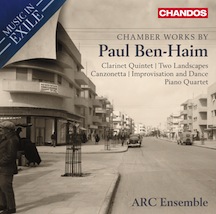It’s tempting to say that the ARC Ensemble’s latest album — its first on the prestigious Chandos label — is its best yet. That’s not because of the fine performances, or the fact that this is likely the first time that most of us are hearing the music of Israeli composer Paul Ben-Haim, but of how these parts make up a seductive listening experience.
- Classical Music 101: What Does A Conductor Do? - June 17, 2019
- Classical Music 101 | What Does Period Instrument Mean? - May 6, 2019
- CLASSICAL MUSIC 101 | What Does It Mean To Be In Tune? - April 23, 2019
ARC Ensemble artistic director Simon Wynberg has outdone himself in curating this collection of chamber works for the group’s ongoing Music in Exile series, previously released under the wing of the RCA Red Seal label.
Wynberg and his colleagues are not just shining light on fine but forgotten music from the late 19th and early-to-mid 20th centuries or underlining how art and politics are not as separate as many of us would like to think them to be. They are also filling the vast blank spaces between tonal and atonal writing in 20th century Western music.
 All this aside, we get 77 minutes of wonderful listening on this album, which is arranged more or less chronologically.
All this aside, we get 77 minutes of wonderful listening on this album, which is arranged more or less chronologically.
We start in Germany, circa 1921, when Paul Frankenburger, a talented composer not yet 25, hatches a harmonically rich, thematically complex three-movement Piano Quartet. This is music clearly influenced by Johannes Brahms, Richard Strauss and Erich Korngold.
The next thing we hear is music from what began as exile in Palestine in 1933, and ended up as a rich, productive life as Paul Ben-Haim, one of modern Israel’s founding composers: Two Landscapes for viola and piano, two gorgeous tone pictures inspired by his adoptive country.
Also on the disc are a seductive piano piece, Canzonetta, from a set of five pieces dating from 1944, a fiery, distinctly Hebraic Improvisation and Dance for violin and piano from 1939 and, the crowning piece on this album, a 1941 Quintet, revised in 1965, for clarinet and string quartet.
Much of this music was recorded using manuscript scores or, in the case of the Quartet, a reconstruction meticulously carried out for this project.
The audio quality on the recording — a nice mix of close and spacious — is excellent. It was made at Koerner Hall in January, just before the concert season resumed after the Christmas break.
The ARC Ensemble contains some of Canada’s finest classical musicians — people who shine as soloists as well as collaborators. They all do admirable work here: violinists Marie Bérard (the COC Orchestra’s concertmaster), Benjamin Bowman (National Ballet Orchestra concertmaster) and Erika Raum, violist Steven Dann, Bryan Epperson (COC Orchestra principal cello), clarinettist Joaquin Valdepeñas (TSO principal clarinet) and pianists Dianne Werner and David Louie.
How lucky are the students at the Royal Conservatory’s Glenn Gould Professional School for having such exemplary teachers, and how lucky the world is to have the ARC Ensemble boldly set forth along Western music’s lush, overgrown paths.
For more on the album, click here.
The ARC Ensemble has spent quite a bit of time on tour outside of Canada, so it’s great to know they’ll be back to perform in these parts in September — in Stratford on the 21st and at Koerner Hall on the 29th. For details of the Toronto concert, which will feature a rare performance of the Piano Quintet by Mariuo Castelnuovo Tedesco, click here.
+++
For a taste of Ben-Haim’s mid-1940s aesthetic, here is Arthur Rubinstein Piano Competition contestant Marouan Benabdallah playing all of the Five Pieces for Piano in 2011:
John Terauds
- Classical Music 101: What Does A Conductor Do? - June 17, 2019
- Classical Music 101 | What Does Period Instrument Mean? - May 6, 2019
- CLASSICAL MUSIC 101 | What Does It Mean To Be In Tune? - April 23, 2019




